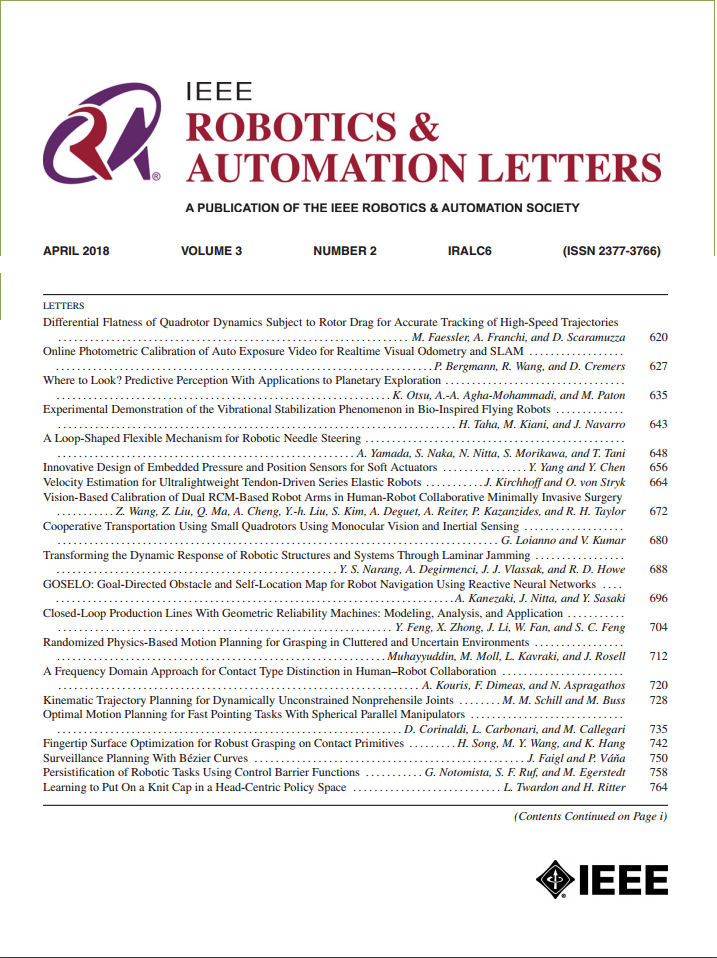JingWei: A Waterfowl-Inspired Flapping-Wing Robot With Multimodal Aerial-Aquatic Mobility
IF 5.3
2区 计算机科学
Q2 ROBOTICS
引用次数: 0
Abstract
Aerial-aquatic amphibious robots can enhance adaptability to complex environments and have become a research hotspot in recent years. Waterfowl in nature exhibit remarkable multimodal cross-domain locomotion capabilities. Inspired by the aerial flight and aquatic swimming behavior of waterfowl, we propose a biomimetic flapping-wing aerial- aquatic robot called JingWei. JingWei achieves flight attitude control through the integration of flapping wings and stroke plane adjustment, enabling vertical takeoff, hovering, and six degrees of freedom (DoF) free flight. Its biomimetic flippers with asymmetric stiffness flexure hinges, fabricated using the Smart Composite Microstructures (SCM) method, are paired with a lightweight paddling mechanism, allowing efficient movement on water surface. The amphibious robot has a width of 36 cm and a weight of 39.4 g. JingWei is capable of sustained flight for 5.4 minutes or swimming for approximately 1.5 hours, with mode transitions between swimming and flying completed in under 0.8 seconds. Through experiments on flight, swimming, and mode transitions, we validated the robot's multimodal locomotion capabilities, providing new insights into the system design of biomimetic aerial-aquatic robots.经纬:一种受水禽启发的具有多模态航水机动能力的扑翼机器人
气水两用机器人能够增强对复杂环境的适应能力,成为近年来的研究热点。自然界中的水禽表现出非凡的多模态跨域运动能力。受水禽空中飞行和水中游泳行为的启发,我们提出了一种仿生扑翼水上空中机器人“精卫”。经纬通过扑翼和行程平面调节的一体化实现飞行姿态控制,实现垂直起飞、悬停、六自由度自由飞行。采用智能复合微结构(SCM)方法制造的具有非对称刚度柔性铰链的仿生鳍,与轻量级划桨机构配合使用,可在水面上高效移动。这款水陆两栖机器人宽36厘米,重39.4克。经纬能够持续飞行5.4分钟或游泳约1.5小时,在游泳和飞行之间的模式转换在0.8秒内完成。通过飞行、游泳和模式转换实验,验证了机器人的多模式运动能力,为仿生航空-水生机器人的系统设计提供了新的见解。
本文章由计算机程序翻译,如有差异,请以英文原文为准。
求助全文
约1分钟内获得全文
求助全文
来源期刊

IEEE Robotics and Automation Letters
Computer Science-Computer Science Applications
CiteScore
9.60
自引率
15.40%
发文量
1428
期刊介绍:
The scope of this journal is to publish peer-reviewed articles that provide a timely and concise account of innovative research ideas and application results, reporting significant theoretical findings and application case studies in areas of robotics and automation.
 求助内容:
求助内容: 应助结果提醒方式:
应助结果提醒方式:


